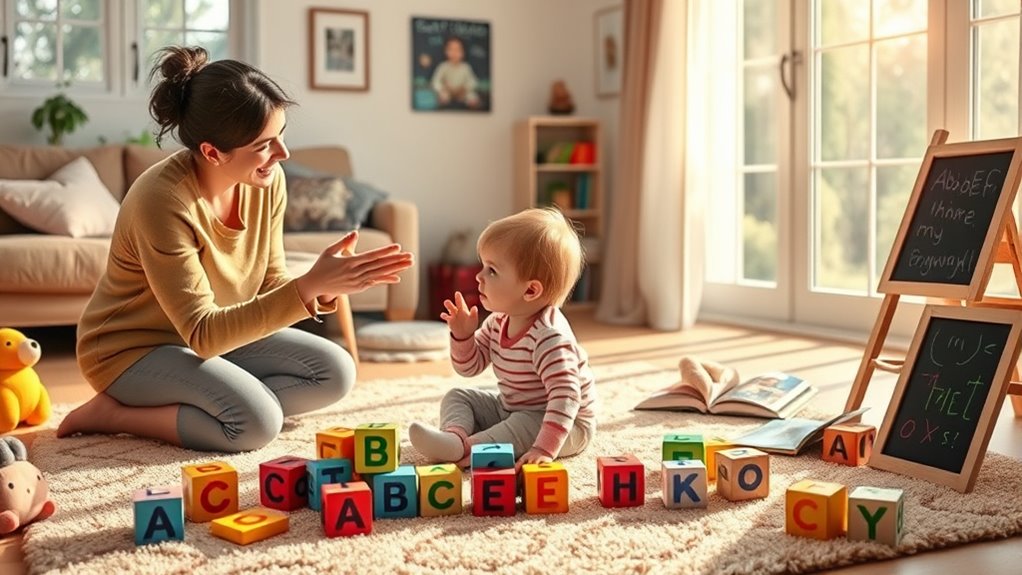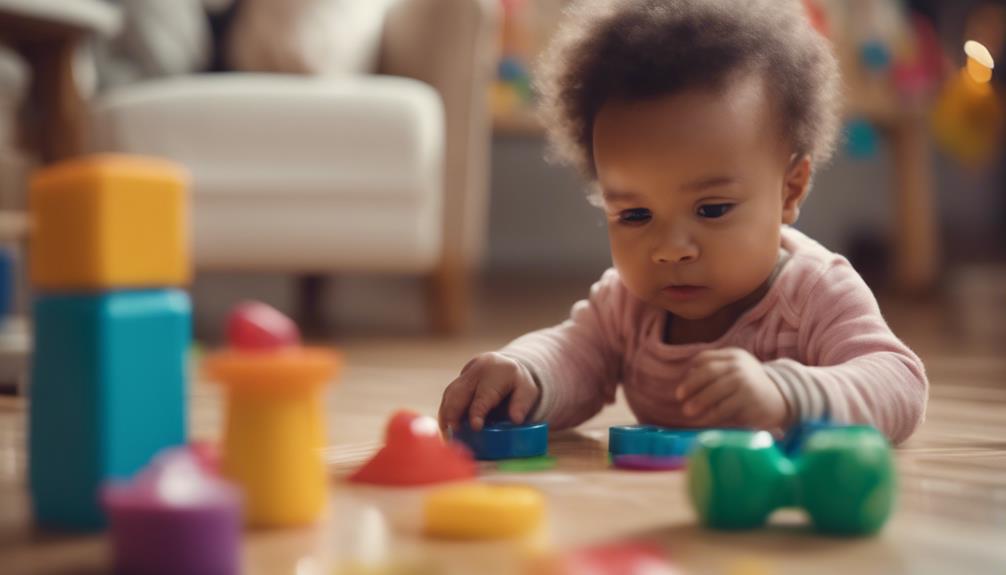If your toddler is unusually quiet, it’s important to observe how they respond to their name, gestures, and familiar voices. While some toddlers are naturally quieter, signs of delay include limited eye contact, lack of response to social cues, little interest in engaging with others, and slow vocabulary growth. If these signs persist or worsen, it may be time to seek professional advice. Keep going; you’ll discover more ways to support your child’s communication development.
Key Takeaways
- Consistent lack of gestures, babbling, or response to name by 12 months may indicate a delay.
- Limited vocabulary growth and minimal interest in language activities suggest a need for evaluation.
- Rarely mimics sounds or words, and shows little engagement in social interactions, signaling possible developmental concerns.
- Absence of eye contact and difficulty responding to facial cues can point to social or communication delays.
- Persistent quietness combined with behavioral cues like frustration or avoidance warrants professional assessment.
When Does Typical Toddler Speech Development Occur?

Most toddlers begin to say their first words around 12 months old, but speech development varies from child to child. During this time, you’ll notice key speech milestones, such as gesturing, vocalizing, and experimenting with sounds. Typically, by 18 months, toddlers start combining two words to express their needs, marking an important phase of language acquisition. Some children may reach these milestones earlier or later, and that’s usually normal. However, understanding when these milestones should occur helps you gauge your child’s progress. Keep in mind that individual differences exist, and growth patterns can vary. Overall, consistent progression through these stages indicates healthy speech development, but awareness of these milestones helps you identify when your toddler might need additional support. Additionally, fostering artistic expression and curiosity can contribute positively to overall communication skills and cognitive growth. Recognizing signs of speech delay early can ensure timely intervention and support for your child’s development. Being aware of individual differences in speech milestones can help prevent unnecessary concern and promote patience during your child’s language journey.
Recognizing the Difference Between Quietness and Delayed Speech

Understanding whether your toddler is simply quiet or experiencing a speech delay is crucial for early intervention. Quietness can be normal during quiet play or when they’re observing their surroundings. However, if your child consistently shows signs like limited non-verbal cues, such as minimal gestures or facial expressions, it may signal a delay. To distinguish between quietness and delay:
- Observe if your toddler responds to their name or familiar voices.
- Note if they make eye contact during interactions.
- Watch for their use of gestures like pointing or waving.
- Pay attention to their engagement during quiet play—are they content or withdrawn? Recognizing non-verbal communication can help assess their social and emotional development more accurately. Additionally, understanding child development milestones can provide insight into whether their progress aligns with typical growth patterns. Recognizing how vibrational energy influences their mood and interactions can also be helpful in understanding their behavior. Moreover, being aware of early intervention strategies can make a significant difference if delays are identified. If these cues seem limited, consider consulting a specialist. Recognizing these differences early can lead to timely support if needed.
Common Signs That Indicate a Potential Speech Delay

If your toddler isn’t showing steady vocabulary growth, it might be a sign of a delay. You’ll also notice if they don’t repeat sounds or words often or use gestures like pointing or waving. Paying attention to these signs can help you determine if your child needs extra support. Additionally, being aware of developmental milestones can provide further insight into whether their speech development is on track. Recognizing the importance of self-awareness in observing your child’s behaviors can help you take appropriate steps early on.
Limited Vocabulary Growth
A limited vocabulary growth in your toddler can be a key sign that they might be experiencing a speech delay. If your child isn’t adding new words or phrases over time, it’s worth paying attention. You can encourage growth through engaging activities like language games and storytelling techniques, which promote word learning. Watch for these signs:
- Struggling to name familiar objects or people
- Using only a few words consistently
- Repeating the same words or phrases without expanding vocabulary
- Showing little interest in new words or conversations
- Spoken language development is influenced by various factors, including cognitive and emotional health. Practicing stillness can sometimes help improve a child’s focus and emotional regulation, which may positively impact language learning. Engaging in sensory activities can also support their overall development and responsiveness to communication cues. Additionally, understanding the importance of early intervention can make a significant difference in addressing potential delays. If these patterns persist, your child may need extra support. Early intervention can help improve their language skills, so consider consulting a speech-language pathologist for personalized guidance.
Lack of Sound Repetition
One clear sign that your toddler may be experiencing a speech delay is a lack of sound repetition. If they rarely mimic sounds or words you say, it could indicate a delay. Repetition is a vital step in language development, helping children practice sounds and build vocabulary. Engaging in activities like music therapy can encourage sound imitation through fun, rhythmic exercises. Additionally, introducing sign language can support communication while your child develops spoken words, reducing frustration. If your toddler isn’t repeating sounds or words even after consistent exposure, consider consulting a speech-language pathologist. Early intervention can make a significant difference, and techniques like music therapy and sign language can be effective tools in encouraging sound repetition and overall language growth. Moreover, understanding AI’s role in cybersecurity and healthcare can inform the development of supportive tools for speech therapy and early diagnosis. Recognizing the importance of developmental milestones helps set realistic expectations and guides timely support.
Minimal Gesture Use
Minimal gesture use can be a key indicator that your toddler might be experiencing a speech delay. If their gesture frequency is low, they may not be using nonverbal cues to communicate effectively. Watch for signs like limited pointing, waving, or nodding, which are common ways toddlers express needs and interests. Consider these points: 1. Your child rarely uses gestures to show or request things. 2. They seem to rely solely on crying or fussing instead of nonverbal cues. 3. They don’t imitate gestures or actions you demonstrate. 4. Their overall gesture repertoire appears limited compared to peers. Low gesture frequency can hinder language development, so paying attention to nonverbal cues helps identify early signs of a speech delay. Recognizing minimal gesture use is vital for early intervention, as nonverbal communication plays a critical role in language acquisition. Early detection of communication issues can significantly improve outcomes for children with speech delays, especially when combined with awareness of other developmental milestones such as vocalization patterns and social engagement. Additionally, observing the child’s ability to respond to their name can provide further insight into their receptive communication skills. Monitoring gestural development can also help identify children who may need targeted support.
The Importance of Listening and Observing Your Child’s Communication

By paying close attention to your child’s early cues and how they communicate, you can spot potential issues sooner. Keep track of their milestones to see if they’re progressing as expected. Observing how they interact socially also provides valuable clues about their developing communication skills. Incorporating mindful decluttering strategies can help create a more organized environment that supports your child’s developmental needs.
Recognize Early Cues
Paying close attention to your toddler’s early cues is essential in identifying potential speech delays. Observing how they communicate helps you understand if they’re on track or need extra support. Look for signs like limited gestures, absence of babbling by 12 months, or difficulty imitating sounds. To encourage development, focus on language enrichment through everyday interactions and play-based learning. Here are some key cues to watch:
- Responding to their name or simple commands
- Using gestures like pointing or waving
- Making sounds or babbling consistently
- Showing interest in conversations or songs
Recognizing these early signals allows you to foster communication skills and seek help if needed, ensuring your child gets the support they deserve to thrive.
Track Communication Milestones
Observing your child’s communication milestones provides valuable insight into their developmental progress. By tracking their language milestones, you can notice how their communication patterns evolve over time. Pay attention to the words they use, how they combine sounds, and their ability to respond to your voice. Consistent observation helps identify whether they’re meeting typical benchmarks or showing delays. For example, if your toddler isn’t babbling by 12 months or isn’t using simple words by 18 months, it could signal a need for further evaluation. Keeping a record of these milestones allows you to spot patterns and changes that might indicate speech delays or other concerns. Listening carefully and observing your child’s communication helps you understand their developmental journey and when to seek professional advice.
Observe Social Interactions
Listening carefully and watching how your child interacts with others can reveal important clues about their communication development. Pay attention to social cues they give and how they navigate peer interactions. Children who struggle with these skills might be showing signs of a delay.
Consider these points:
- They rarely make eye contact during conversations.
- They have difficulty responding to social cues like facial expressions or gestures.
- They avoid or seem uninterested in playing with peers.
- They don’t initiate or respond to simple social exchanges.
Noticing these behaviors early can help you determine whether your child needs extra support. Observing their social interactions offers valuable insight into their overall communication skills and emotional development.
How Behavioral Cues Can Signal Speech Challenges

Since children often communicate through gestures and behaviors before developing full speech, noticing certain cues can help you identify potential challenges early on. Watch for limited gestural communication, like rarely pointing or waving, which may signal speech delays. Emotional cues, such as frustration or withdrawal when trying to communicate, can also indicate difficulties. Observe how your toddler responds to others and their environment. For example:
| Behavioral Cue | Possible Significance |
|---|---|
| Minimal gestural communication | Trouble expressing needs non-verbally |
| Frustration or tantrums | Difficulty conveying feelings or requests |
| Avoidance of eye contact | Sign of social or communicative challenges |
| Limited response to sounds or words | Possible hearing or speech processing issues |
These cues can help you decide if further evaluation is needed.
When to Seek Professional Evaluation and Support

If you notice persistent behavioral cues like limited gestures, frustration, or avoidance of eye contact despite giving your child time to develop, it may be time to consult a professional. Early evaluation can help identify if your toddler needs targeted support. Consider seeking help if:
- They aren’t responding to their name by age 12 months.
- They show little interest in peer interaction or playing alongside others.
- Speech development stalls beyond age 2, despite encouragement.
- You notice difficulty with non-verbal cues like gestures or facial expressions.
Professionals may recommend interventions like music therapy, which encourages speech through rhythm and sound, or social activities that foster peer interaction. Addressing concerns early can make a significant difference in your child’s communication skills.
Strategies to Encourage Speech Development at Home

You can support your toddler’s speech development at home by engaging them in everyday conversations and activities. Use storytelling techniques to make language fun—pause for questions, use expressive voices, and encourage your child to repeat or add to stories. Incorporate play-based activities like pretend play, singing songs, and reading picture books together. These activities naturally promote vocabulary and communication skills. Be patient and responsive, giving your child time to process and respond. Describe what you’re doing, ask simple questions, and praise their efforts. Consistent interaction helps build confidence and interest in speaking. Remember, creating a language-rich environment at home encourages your toddler to experiment with words and develop their speech skills naturally.
The Role of Early Intervention in Supporting Speech Growth

Early intervention plays a crucial role in supporting your child’s speech development, especially when delays are identified early. The sooner you seek help, the better the chances for positive progress. Early intervention can include activities like language enrichment and encouraging social play, which promote natural speech growth. Here are four ways it makes a difference:
- It provides tailored strategies to address your child’s specific needs.
- It fosters increased opportunities for social interactions, boosting language skills.
- It helps caregivers learn effective ways to support speech at home.
- It encourages early, consistent support, reducing long-term delays.
Frequently Asked Questions
How Can I Differentiate Between a Shy and a Speech-Delayed Child?
You might notice your child’s social interactions and temperament traits to differentiate shyness from a speech delay. If your toddler is shy, they may prefer quiet activities and gradually warm up around others. However, if they show limited speech development despite normal social interest, it could suggest a delay. Observe whether they attempt to communicate or respond to social cues; persistent difficulties might require professional evaluation.
Are There Specific Ages When Speech Delays Are More Noticeable?
You might notice speech delays more clearly at certain age milestones, like around 12 or 18 months, when toddlers typically start saying words or combining sounds. Keep in mind developmental variations; some children develop speech skills later without issues. If your child isn’t meeting key milestones or shows little to no attempt to communicate by ages 2 or 3, it’s a good idea to consult a specialist.
Can Environmental Factors Affect My Child’s Speech Development?
You might wonder if environmental impact and parenting practices influence your child’s speech development. Research suggests that a language-rich environment, with plenty of conversations and reading, can boost speech skills. Conversely, limited interaction or noisy settings may hinder progress. By actively engaging with your toddler, using positive parenting practices, and creating a supportive environment, you help foster their communication skills and reduce potential delays.
What Are Common Misdiagnoses Related to Speech Delays?
Misdiagnosis concerns often arise because speech delays can have overlapping symptoms with other issues, like hearing problems or developmental disorders. You might worry that your child’s quietness is mistaken for a speech delay when it’s caused by shyness or environmental factors. To avoid this, guarantee thorough evaluations from specialists who can differentiate between true speech delays and other conditions, providing accurate diagnoses and effective support tailored to your child’s needs.
How Do Cultural Differences Influence Perceptions of Quietness in Toddlers?
Think of cultural differences as a tapestry that shapes your perception of quietness in toddlers. You might see your child’s silence as a sign of shyness or obedience, influenced by cultural communication norms and parenting expectations. In some cultures, quietness is valued, while in others, expressive speech is encouraged. Recognizing these nuances helps you understand whether your child’s quietness is normal or if they might need support to develop their communication skills.
Conclusion
By staying attentive, by observing your child’s quiet moments and verbal attempts, by recognizing early signs and acting promptly, you can support their speech development effectively. Trust your instincts, seek guidance when needed, and create a nurturing environment that encourages communication. Remember, your involvement makes a difference—your encouragement, your patience, your support. Together, you can help your little one find their voice, build confidence, and embrace the joy of connecting through words.










